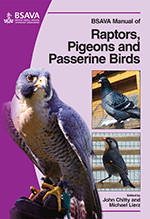
Full text loading...

Captive raptors are frequently exposed to many infectious diseases, especially from their food sources. Protecting husbandry conditions with particular attention to biosecurity and food preparation will significantly reduce the chance of infections in captive birds. This chapter examines viral disease, bacterial disease, fungal disease and control of infectious disease in captive raptors.
Raptors: infectious diseases, Page 1 of 1
< Previous page | Next page > /docserver/preview/fulltext/10.22233/9781910443101/9781910443101.19-1.gif

Full text loading...



